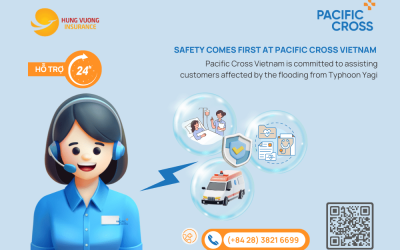What is chronic obstructive pulmonary disorder (copd)?
By Ha Dang Medically reviewed by Dr. Duyen Le.
Know the basics
What is chronic obstructive pulmonary disorder (COPD)?
There are two main parts of your lung: the bronchial tubes (also called airways) and alveoli (also called air sacs). There is also the trachea (or windpipe). Then you breathe in, the air goes from your windpipe through the bronchial tubes to the alveoli. From the alveoli, oxygen goes into your blood while carbon dioxide moves out of your blood.
Chronic Obstructive Pulmonary Disease, or COPD, refers to a group of diseases that cause problems to the airflow by blocking the bronchial tubes or cause damage in any part of your lungs. Patients with COPD often feel very hard to breath, though it is much worse then frequent coughing or “smoker’s cough”. COPD includes two main illnesses. However, most people who have COPD have both of these conditions.
- Chronic bronchitis: Bronchitis is the inflammation of the lining of the bronchial tubes. The lining in your bronchial tubes of your lungs gets red, swollen, and full of mucus. This mucus blocks your tubes and makes it hard to breathe.
- Emphysema: Emphysema gradually damages the air sacs (alveoli) in your lungs, making you progressively more short of breath. You lose alveoli in your lungs. This makes it hard for you to get oxygen into and carbon dioxide out of your blood. It also makes it harder to breathe out.
How common is chronic obstructive pulmonary disorder (COPD)?
COPD is most common in people wh
Know the symptoms
What are the symptoms of chronic obstructive pulmonary disorder (COPD)?
COPD affect the respiratory system, thus you will experience shortness of breath frequently. COPD can cause a variety of symptoms, including:
- Chronic (long-lasting) cough.;
- A cough that produces mucus, which can be clear, white, yellowish-gray or green in color. Rarely, it may be streaked with blood;
- An increase in respiratory infections (such as flu and colds);
- Shortness of breath, especially during physical activity;
- A tight feeling in the chest;
- Wheezing;
- Fatigue;
- Slight fever and chills.
At first, you may have no symptoms or only mild symptoms. But COPD is a progressive disease, meaning the symptoms start slowly and get worse over time. COPD symptoms develop over the course of many years. Eventually, the symptoms begin to affect your activity levels and quality of life. Some severe symptoms may require treatment in a hospital. You should seek emergency care if you have the following problems:
- You’re having a hard time catching your breath or talking.
- Your lips or finger nails turn blue or gray. (This is a sign of a low oxygen level in your blood.)
- You’re not mentally alert.
- Your heartbeat is very fast.
- The recommended treatment for symptoms that are getting worse isn’t working.
When should I see my doctor?
COPD is most common in people who are heavy smokers and older than 65. However, it can be managed by reducing the risk of COPD. Quitting smoking is the most effective way to prevent COPD.
Know the causes
What causes chronic obstructive pulmonary disorder (COPD)?
COPD is caused by damage to the lungs. This type of damage typically occurs when you regularly breathe in irritants over a long period of time. Common irritants include:
- Cigarette smoke (including second-hand smoke). Approximately 80% to 90% of COPD cases are caused by long-term smoking;
- Chemical fumes, gases, vapors, or mists;
- Dust;
- Indoor air pollution (such as solid fuel used for cooking and heating);
- Outdoor air pollution;
- Occupational dusts and chemicals (vapours, irritants and fumes);
- Frequent lower respiratory infections during childhood.
Know the risk factors
What increases my risk for chronic obstructive pulmonary disorder (COPD)?
You would thought that men are more likely to have COPD from smoking, but woman are accounted for more cases of COPD. This is because the increased number of female smoker in developed country. Combined with the higher risk of exposure to indoor air pollution (such as solid fuel used for cooking and heating) in low-income countries, the disease now affects men and women almost equally.
You are at higher risk of COPD if you are:
- People aged 65–74 years.
- Non-Hispanic whites.
- Those with a history of asthma.
- Current or former smokers.
Understand the diagnosis & treatment
The information provided is not a substitute for any medical advice. ALWAYS consult with your doctor for more information.
How is chronic obstructive pulmonary disorder (COPD) diagnosed?
Because COPD develops slowly, it is frequently diagnosed in people aged 40 or older. Your doctor will diagnose COPD based on your signs and symptoms, your medical and family histories, and test results.
Your doctor may ask whether you smoke or have had contact with lung irritants, such as secondhand smoke, air pollution, chemical fumes, or dust. Your doctor will also examine you and use a stethoscope to listen for wheezing or other abnormal chest sounds.
- Lung function tests: Lung function tests measure how much air you can breathe in and out, how fast you can breathe air out, and how well your lungs deliver oxygen to your blood.
- Spirometry: you will take a deep breath and then blow as hard as you can into a machine called spirometer. The machine measures how much air you breathe out and how fast you can blow air out.
- A chest x-ray or chest CT scan: these tests create pictures of the structures inside your chest, such as your heart, lungs, and blood vessels. The pictures can show signs of COPD.
- An arterial blood gas test: This blood test measures the oxygen level in your blood using a sample of blood taken from an artery. The results from this test can show how severe your COPD is and whether you need
How is chronic obstructive pulmonary disorder (COPD) treated?
Unfortunately, there is yet to have a cure for COPD. The best method to deal with COPD is prevention and management. The goals of COPD treatment include:
- Relieving your symptoms.
- Slowing the progress of the disease.
- Improving your ability to stay active.
- Preventing and treating complications.
Medicines
- Bronchodilators: medications to make breathing easier by relaxing the muscles in the lungs and widening the airways.
- Combination bronchodilators plus inhaled glucocorticosteroids (a type of steroid to reduce inflammation in the lungs).
Vaccines
- Flu shots.
- Pneumococcal vaccine (a vaccine to prevent diseases is caused by a bacterium known as Streptococcus pneumoniae, or pneumococcus)
- Oxygen therapy.
Surgery
Surgery usually is a last resort for people who have severe symptoms that have not improved from taking medicines. It mainly related to emphysema include bullectomy and lung volume reduction surgery (LVRS). A lung transplant might be an option for people who have very severe COPD.
- Bullectomy removal of air pockets (bulla) in the lung;
- Lung volume reduction surgery;
- Lung transplant.
The World Health Organization (WHO) has developed a plan to prevent and control noncommunicable diseases (diseases that do not pass from one person to another). WHO aims to:
- Raise awareness about the global epidemic of noncommunicable diseases.
- Create more healthy environments, especially for poor and disadvantaged populations.
- Decrease risk factors of noncommunicable disease, such as tobacco use, unhealthy diet and physical inactivity.
- Prevent premature deaths and avoidable disabilities from major noncommunicable diseases.
Lifestyle changes & home remedies
What are some lifestyle changes or home remedies that can help me manage chronic obstructive pulmonary disorder (COPD)?
Lifestyle changes and treatments can help you feel better, stay more active, and slow the progress of the disease.
Quit smoking and avoid lung irritants
If you smoke, it is better to quit. Smoking is the leading culprit of COPD. Talk with your doctor about programs and products that can help you quit.
Try to avoid lung irritants that can contribute to COPD. Examples include secondhand smoke, air pollution, chemical fumes, and dust.
Keep these irritants out of your home. If your home is painted or sprayed for insects, have it done when you can stay away for a while.
Keep your windows closed and stay at home (if possible) when there’s a lot of air pollution or dust outside.
Get ongoing medical care
It is important to get ongoing medical care. Take all of your medicines as your doctor prescribes. Make sure to refill your prescriptions before they run out. Bring a list of all the medicines you are taking when you have medical checkups.
Talk with your doctor about whether and when you should get flu (influenza) and pneumonia vaccines. Also, ask him or her about other diseases for which COPD may increase your risk, such as heart disease, lung cancer, and pneumonia.
Manage the disease and its symptoms
Following an eating plan to get enough calories and nutrients you need, because when having COPD, you may have trouble eating.
Stay active by regularly do physical activities. Physical activity can strengthen the muscles that help you breathe and improve your overall wellness. But firstly you should talk with your doctor about what types of activity are safe for you.
Put items that you need often in one place to avoid reaching.
Find very simple ways to cook, clean, and do other chores. For example, you might want to use a small table or cart with wheels to move things around and a pole or tongs with long handles to reach things.
Ask for help moving things around in your house so that you won’t need to climb stairs as often.
Keep your clothes loose, and wear clothes and shoes that are easy to put on and take off.
Depending on how severe your disease is, you may want to ask your family and friends for help with daily tasks.
Prepare for emergencies
Keep phone numbers handy for your doctor, hospital, and someone who can take you for medical care.
If you have any questions, please consult with your doctor to better understand the best solution for you.
Hello Health Group does not provide medical advice, diagnosis or treatment.
Review Date: January 4, 2017 | Last Modified: January 4, 2017









